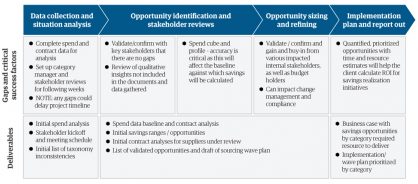- Point of view
Sourcing opportunity assessments
Immediate cash management improvements for uncertain times

Previously profitable and financially stable companies across every industry are facing a new economic reality. As a result, profit and cash-flow improvements are most CEOs' and CFOs' top priority.
As economies slow and market dynamics shift on an almost weekly basis, organizations must face the challenge of doing more with less.
Sourcing opportunity assessments are one way organizations can optimize their use of resources and identify potential cost management improvements. These assessments take a step back and use a structured approach to identify where to target first, where the greatest savings opportunities lie, and how to accelerate profit and loss (P&L) impact.
This point of view examines the four stages of a detailed cost reduction opportunity assessment using analytics, benchmarks, contract reviews, and supplemental category expertise.
Leave no stone unturned
Ultimately the outcome of these assessments is to identify, quantify, and prioritize sourcing opportunities to drive immediate and medium-term cost reductions and cashflow improvements. These opportunities are usually missed because of highly fragmented spend across suppliers, reactively managed contract renewals, and under-resourced or under-trained procurement teams.
Most companies have already investigated sourcing opportunities, focused on cost and spend management, during their annual budgeting and financial planning season. But how many of these assessments truly leave no stone unturned when scrutinizing how money is spent across the organization?
Without external input and benchmarking support, money is almost certainly left on the table.
Take a copy for yourself
Turning sourcing opportunity assessments into actual cost and cash improvements
Potential sourcing opportunities identified by an assessment must then be realized, either with direct incumbent negotiations and/or strategic-sourcing initiatives. Best-in-class assessments show savings of approximately 4.79% against external spend, year-over-year1, compared to the 2-3% range we typically see for spend that is not proactively assessed and managed. For a company with $1 billion in total spend, this equates to incremental savings of $18-$28 million each year.
To maximize potential cost management improvements, we recommend four distinct and interdependent steps:
- Data collection and situation analysis
- Opportunity/hypothesis identification and stakeholder reviews
- Opportunity sizing, refining, and validation
- Implementation planning
Figure 1: Genpact's sourcing opportunity assessment approach

The sourcing opportunity assessment identifies the total cost reductions and cashflow improvements possible and then lays out a roadmap of how to achieve them. How long it takes will depend on the size of the organization and the number of geographies assessed.
Data collection and situation analysis
This initial phase is fundamental because it lays the foundation for the entire assessment and subsequent hypothesis testing. Missing contractual documents or incomplete data will delay benchmarking exercises and present an incomplete picture for the assessment team to analyze. To avoid these gaps, companies should set data- completeness targets and make sure they're met ahead of starting the clock on the formal four-to-five week assessment period.
Opportunity/hypothesis identification and stakeholder reviews
As contracts and payment data are only part of the story, the assessment team should also begin its analysis by testing and validating a set of hypotheses. Part of this validation will come from qualitative – and not just quantitative – insights such as:
- The history of relationships with key suppliers that led to the commercial terms in the latest agreements
- Internal projects that influence the ability for a company to move away from using an incumbent supplier
- Operations metrics that detail how a company interacts with key suppliers. This can include payment term performance, supplier risk, and supplier performance management indicators, and core supply chain processes such as fulfillment and demand planning
The spend cube development process is then a critical next step. When combined with the spend profile, it creates a baseline against which savings projections can be calculated. If the baseline is incorrect, or deemed untrustworthy, this will have a direct impact on the output's credibility from the assessment process.
Opportunity sizing, refining, and validation
This stage requires close collaboration with finance to ensure that everyone agrees on how to calculate savings against each opportunity. This should not start until the spend cube and spend baseline have been finalized. It's important to have validation, confirmation, and buy-in from the impacted internal stakeholders as well as budget holders.
Implementation planning
The plan and overall roadmap for how to implement each opportunity, how long it will take, and whom to involve are as important as the opportunity identification. Plans should be detailed and realistic based on available resources. In the current COVID-19 environment, many organizations are running lean, with key procurement and project management staff having to take on multiple roles. Expecting these team members to drive incremental and accelerated cost takeout programs can be unrealistic. Organizations should explore how self-funded commercial terms can support these initiatives with service providers such as Genpact.
Execution, governance, and tracking
This final phase comes after the sourcing opportunity assessment is complete and enables execution against the assessment results. We know from our experience running procurement operations that the opportunities must be realistic, traceable, and sustainable – otherwise the benefits identified never truly impact the bottom line.
Procurement leaders can play a vital role in responding to the current economic challenges by reducing costs and freeing up cash flow. These assessments enable organizations to identify where the greatest opportunities lie and how to achieve savings quickly.
Learn more about how Genpact can help with source to pay.
Find out more about our sourcing and procurement services
1. The Hackett Group – Source-to-Settle Discussion Metrics, 2019